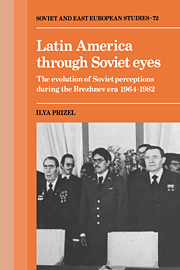 Latin America through Soviet Eyes
Latin America through Soviet Eyes Book contents
- Frontmatter
- Contents
- Preface
- Acknowledgments
- Introduction
- Part I Soviet perceptions of Latin America's global role
- Introduction
- 1 Soviet perceptions of US–Latin American relations
- 2 Latin America's role in the capitalist division of labor
- 3 Latin America's role in the Third World
- 4 Soviet views on Latin America's regional integration
- 5 Soviet conclusions regarding Latin America's ability to conduct an independent foreign policy
- Part II Soviet perceptions of Latin American social structures
- Part III Soviet–Latin American relations during the Brezhnev era
- Part IV Conclusion: the emerging Soviet perception of Latin America and the future of Soviet policy toward the hemisphere
- Conclusions
- Epilogue – Latin America: the Long March
- Notes
- Bibliography
- Index
3 - Latin America's role in the Third World
Published online by Cambridge University Press: 05 February 2012
- Frontmatter
- Contents
- Preface
- Acknowledgments
- Introduction
- Part I Soviet perceptions of Latin America's global role
- Introduction
- 1 Soviet perceptions of US–Latin American relations
- 2 Latin America's role in the capitalist division of labor
- 3 Latin America's role in the Third World
- 4 Soviet views on Latin America's regional integration
- 5 Soviet conclusions regarding Latin America's ability to conduct an independent foreign policy
- Part II Soviet perceptions of Latin American social structures
- Part III Soviet–Latin American relations during the Brezhnev era
- Part IV Conclusion: the emerging Soviet perception of Latin America and the future of Soviet policy toward the hemisphere
- Conclusions
- Epilogue – Latin America: the Long March
- Notes
- Bibliography
- Index
Summary
Latin American attitudes
Before 1961 Latin America often expressed ambivalence toward the Third World. Its unwillingness to consider itself part of the Third World was, in fact, similar to the viewpoint of the Soviets, who usually referred to the Third World as the Afro-Asian bloc. That many Latin American elite felt little communality with the emerging states in Asia and Africa was due largely to the region's long experience of independence and traditional self-perception as being a part of “Christian Western civilization.”
Only in 1961 did Latin America begin to participate in the Non-Aligned Movement (NAM), which had first convened in 1955. Several explanations may be given for why Latin America started to identify more with the Third World. First, Castro's regime, with its activist policy among nonaligned nations, convinced many in Latin America that the NAM might be a new forum in which Latin America could air its grievances against the United States. Added to this was Latin America's need for greater cooperation with the new Asian and African states, whose inclusion in the UN reduced the numeric weight of Latin America within that organization.
Other developments, of course, aided Latin America in shifting its policy toward the Third World. For example, the success of OPEC led Latin American states to join eagerly with other developing countries in price cartels for primary commodities in an attempt to offset the region's declining share of global trade.
- Type
- Chapter
- Information
- Latin America through Soviet EyesThe Evolution of Soviet Perceptions during the Brezhnev Era 1964–1982, pp. 47 - 52Publisher: Cambridge University PressPrint publication year: 1990
